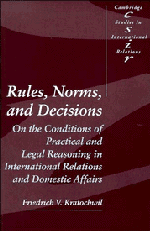 Rules, Norms, and Decisions
Rules, Norms, and Decisions Book contents
- Frontmatter
- Contents
- Acknowledgements
- Introduction: The resort to norms
- 1 Rules, norms, and actions: laying the conceptual foundations
- 2 Anarchy and the state of nature: the issue of regimes in international relations
- 3 The emergence and types of norms
- 4 The force of prescriptions: Hume, Hobbes, Durkheim, and Freud on compliance with norms
- 5 The discourse on grievances: Pufendorf and the “laws of nature” as constitutive principles for the discursive settlement of disputes
- 6 The notion of “right”
- 7 The question of “law”
- 8 The path of legal arguments
- Conclusion: The international legal order, international systems, and the comparative analysis of the practice of states
- Notes
- Index
7 - The question of “law”
Published online by Cambridge University Press: 01 June 2011
- Frontmatter
- Contents
- Acknowledgements
- Introduction: The resort to norms
- 1 Rules, norms, and actions: laying the conceptual foundations
- 2 Anarchy and the state of nature: the issue of regimes in international relations
- 3 The emergence and types of norms
- 4 The force of prescriptions: Hume, Hobbes, Durkheim, and Freud on compliance with norms
- 5 The discourse on grievances: Pufendorf and the “laws of nature” as constitutive principles for the discursive settlement of disputes
- 6 The notion of “right”
- 7 The question of “law”
- 8 The path of legal arguments
- Conclusion: The international legal order, international systems, and the comparative analysis of the practice of states
- Notes
- Index
Summary
INTRODUCTION
The discussion in the preceeding chapter addressed the role of norms when the actors' goals collide and a solution is sought through non-coercive means. By granting equal standing and consideration of each other's interest, by limiting the dispute to identifiable issues, by utilizing norms that satisfy the universalizability criterion, and by adopting the no-harm standard as a substantive principle, the parties deliberately bound the conflict and agreed on a method to resolve their grievances. Although the final distributional outcome is still indefinite, much has been achieved thereby; now only results based on argument and persuasion are considered legitimate. To that extent the “discourse on grievances” shows important similarities and dissimilarities to normal bargaining. Appeals to norms, precedents, “salience,” etc., naturally can be – and usually are – part of the conventional bargaining process. What gives “bargaining” its peculiar characteristic, however, is the latent presence of coercion. Moves therefore oscillate widely, ranging from coercive to noncoercive measures. In the latter case the breaking of the opponent's will rather than the solution of specific issues becomes the main objective. It is this relegation of the original goal to a secondary position and the substitution of coercion for the competition over the scarce original object that changes the nature of the dispute.
Conversely, we see that norms not only transform conflicts by providing “standard” solutions which the parties can utilize if they so desire, but also structure the antagonism between the parties and regulate the pursuit of their respective interests.
- Type
- Chapter
- Information
- Rules, Norms, and DecisionsOn the Conditions of Practical and Legal Reasoning in International Relations and Domestic Affairs, pp. 181 - 211Publisher: Cambridge University PressPrint publication year: 1989
- 1
- Cited by
